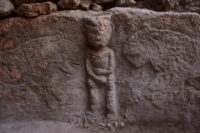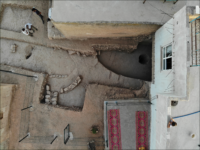A wall relief featuring a man holding his phallus in one hand while two leopards look on is the earliest narrative scene ever found. It was discovered in Sayburc, southeastern Turkey, and dates to the earlier part of the Pre-Pottery Neolithic (10,000 – 6500 B.C.).
The five-figure wall relief depicts a scene with humans and animals in action. In the center, a man holds his penis in his right hand. He is carved in high relief, the only figure on the wall to stand out in three dimensions; the rest are flat. He is flanked by leopards with open mouths that face him. On the west side of the relief are the figures of a man and a bull. The man has his back to the man with the leopards and is holding either a rattle or a snake. The bull is stylized, almost Cubist in concept: shown from the profile like the leopards, but with the head and horns seen from above.
 The figures are captured in movement and relating to each other, there is a cohesive theme and a story being told. Other reliefs from this time have human and animal figures, but without a connecting narrative through-line. In other words, this one has a plot.
The figures are captured in movement and relating to each other, there is a cohesive theme and a story being told. Other reliefs from this time have human and animal figures, but without a connecting narrative through-line. In other words, this one has a plot.
Archaeologists discovered the relief in a rescue excavation under a modern home in the village of Sayburc.
Sayburc is a very modern village built in 1949. The region is replete with prehistoric sites that include the world’s oldest megalithic complexes, Göbekli Tepe and Karahan Tepe. ( c. 9500 B.C.). These sites and 15 others found in this remote, arid part of Anatolia are of incalculable archaeological significance as some of the oldest settlements/religious complexes in the world. The builders were still hunter-gatherers when the megaliths went up. They built homes and communal buildings and settled down there, leaving behind the nomadic lifestyle, but they had not yet transitioned to farming and livestock domestication.
 These sites are renown for the hundreds of T-shaped obelisks carved with figures of wild animals that have been discovered there. In 2021, Sanlıurfa Archeology Museum received reports of obelisk parts being re-used in Sayburc to make garden walls. Archaeologists examined the walls and confirmed they were indeed Neolithic stelae. An excavation ensued. Under two modern homes, archaeologists unearthed a circular pit building carved into the limestone bedrock. Along a perimeter wall 36 feet long, the team discovered a bench formed by the bedrock. It is about three feet high and two feet wide. The relief was carved on the inner face of the bench.
These sites are renown for the hundreds of T-shaped obelisks carved with figures of wild animals that have been discovered there. In 2021, Sanlıurfa Archeology Museum received reports of obelisk parts being re-used in Sayburc to make garden walls. Archaeologists examined the walls and confirmed they were indeed Neolithic stelae. An excavation ensued. Under two modern homes, archaeologists unearthed a circular pit building carved into the limestone bedrock. Along a perimeter wall 36 feet long, the team discovered a bench formed by the bedrock. It is about three feet high and two feet wide. The relief was carved on the inner face of the bench.
In terms of technique and craftsmanship, the flat relief figures are also comparable to other Pre-Pottery Neolithic images in the region. The Sayburç reliefs, however, differ in that the figures form a narrative, with the two individual scenes appearing to be related to one another. This human/animal relationship is emphasised by the interpretation of the T-shaped pillars in Göbeklitepe, which depict stylised humans alongside animal figures (Verhoeven Reference Verhoven2002; Schmidt Reference Schmidt2006a, Reference Schmidt2006b, Reference Schmidt and Yalcin2013). This relationship is also central in the depiction of human figures carrying animals on their backs found at Karahantepe and in the composite sculptures from Nevali Çori, where humans and animals are placed on top of one another. At Sayburç, however, this relationship is presented in a horizontal orientation, creating a different effect. By being represented on the same level, the comparable stature of humans and animals at Sayburç suggests a newly recognised dimension in the narratives of Pre-Pottery Neolithic people. The figures were undoubtedly characters worthy of description. The fact that they are depicted together in a progressing scene, however, suggests that one or more related events or stories are being told.
